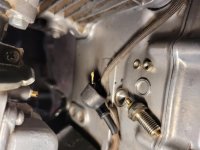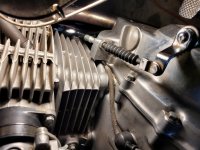kbongos
Veteran Member
So this is nothing new, it seems to have slowly developed over a few years. So oil light turns on or flickers after a good long ride. I am guessing the oil gets warmed up and gets a little thinner. I sometimes give it a little throttle sitting at the stop light to idle higher to avoid the red oil idiot light. I think it's trying to tell me I'm an idiot for not changing the oil more frequently. I did change oil and filter recently, and the oil level is good.
Maybe I should just buy another pressure sensor(I hear they are fairly cheap), or look for a real oil pressure gauge to get a decent measure. I have no burning desire to tear the engine apart. I have learned the oil-pump is a separate assembly that I think could be replaced without removing the engine, just taking side panel off? It has a oil pickup with screen, but I think that requires engine removal?
So mostly just fishing for suggestions on the oil red light of doom and what if anything should be done.
Oh, I have been taking temperature measures with hand held IR scanners. When it's all warmed up and running hot it get's up to 300F or so measured between plug and exhaust. Sometimes it varies from side to side, but that's hopefully attributed to my carbs not being tuned perfectly. I've read it might be useful to get a reading on oil temp, and you could get a gauge and put in the fill hole.
Maybe I should just buy another pressure sensor(I hear they are fairly cheap), or look for a real oil pressure gauge to get a decent measure. I have no burning desire to tear the engine apart. I have learned the oil-pump is a separate assembly that I think could be replaced without removing the engine, just taking side panel off? It has a oil pickup with screen, but I think that requires engine removal?
So mostly just fishing for suggestions on the oil red light of doom and what if anything should be done.
Oh, I have been taking temperature measures with hand held IR scanners. When it's all warmed up and running hot it get's up to 300F or so measured between plug and exhaust. Sometimes it varies from side to side, but that's hopefully attributed to my carbs not being tuned perfectly. I've read it might be useful to get a reading on oil temp, and you could get a gauge and put in the fill hole.




